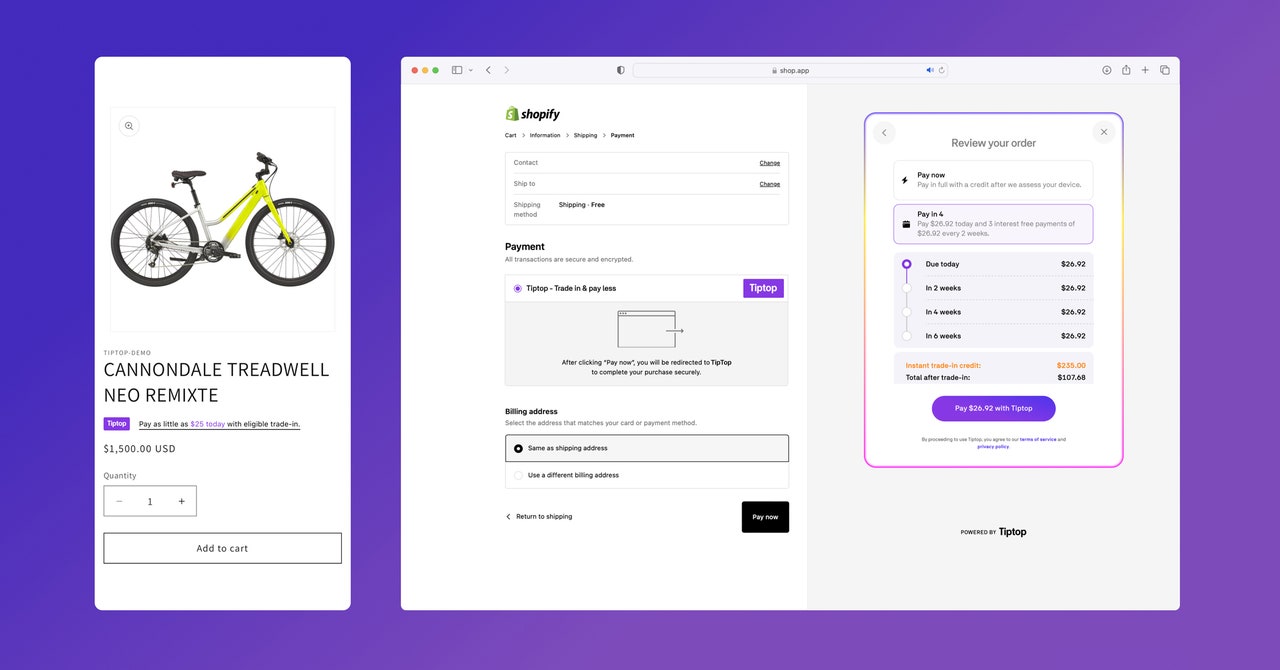Lehmann says Tiptop has cataloged around 50,000 specific products that it will accept as trade-ins. The company will take things like your old phones, laptops, and baby strollers, although some items aren’t eligible for trade-in because they’d be too costly to ship. (You can’t trade in your fridge, sorry.) Behind the scenes, Tiptop uses some algorithms to dynamically estimate the value of everything on its list based on market values and some adjustments for depreciation. The trade-in prices you’ll be offered will obviously vary. Lehmann says the average discount across all devices that have come through Tiptop’s system so far is about $287.
Tiptop is enabled as a payment gateway for Shopify, which means any online merchant that uses Shopify can enable Tiptop as a payment option. Already on the Tiptop wagon are sites like Nothing and Phonedaddy, the baby storage company Cradlewise, the gaming controller maker Backbone, and King of Christmas—a store that sells exactly what the name implies. The merchants selling the item pay a fee to Tiptop just like they would for any other payment processor. That fee is somewhere between 5 and 12 percent, Lehmann says, depending on the value of the item being traded in.
Trade Union
The genesis of Tiptop started after Uber bought Postmates in 2020, when Lehmann says he took some time off to be with family and consider what his post-Postmates life might look like. Turns out the answer was very close to home.
“After a while I started thinking about how my house is full of stuff,” he says.
Not only that, but it was full of the kind of stuff he says is increasingly hard to get rid of. Today’s consumer electronics typically have very quick upgrade cycles, with companies trying to breathlessly parkour their customers into buying the newest thing every year. And once you do, there aren’t always good ways to get rid of last year’s item that you don’t need anymore. Marketplaces like eBay or Craigslist require some lift; you need to take photos, write a listing, post it, then interact with buyers and ultimately ship it out yourself or go meet somebody in a parking lot for a handoff. Trade-in programs offered by manufacturers like Apple or Google are limited to products sold by that manufacturer, and there are sometimes strings attached, like committing to buying another device or service plan, or only getting store credit. Rather than deal with these limitations and hassles, people often just put their old device into a box or a drawer, where it goes unused.
Lehmann sees all that stuff you’ve got lying around as a resource.
“In a nutshell, what Tiptop tries to do is give US households access to a bank account they didn’t know about,” Lehmann says. “If you want the newest thing, you need to do something with the old thing.”
It’s possible that Tiptop could help usher in a new era of reusing devices, but it’s also possible the opposite could happen. Lucas Gutterman, the director of the Designed to Last campaign at the advocacy group US PIRG, worries that helping people pay less for a newer device could entice them to upgrade more often, perpetuating the demand for that sort of rapid upgrade cycle that Lehmann says is part of the problem.

